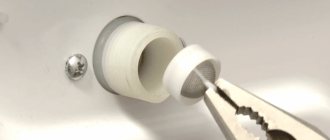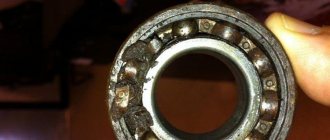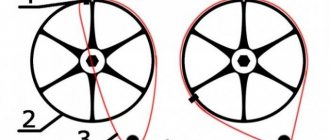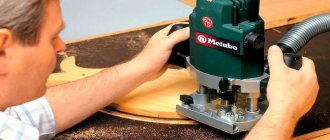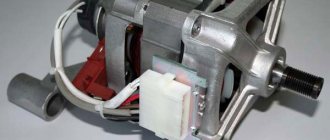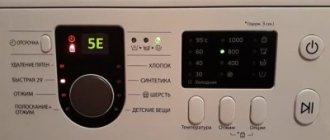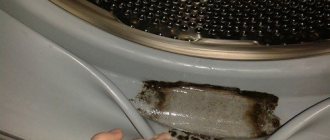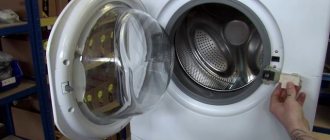When purchasing a washing machine, it is important to know the rules for its installation and connection. Particular attention should be paid to the transportation bolts; we will figure out where they are on the washing machine, what they look like, how and when they need to be removed and put back.
The text is relevant for automatic washing machines of foreign and domestic production: AEG, Ardo, Beko, Bosch Maxx, Daewoo, DEXP, Candy Aqua, Aquamatic ; Gorenje / Burning, Haier / Hayer, Hansa / Hansa, HiSense / Hisense, Hotpoint Ariston / Hotpoint Ariston, Electrolux / Electrolux, Indesit / Indesit, Leran / Leran, LG Direct Drive, 6Motion / LG Direct Drive, 6Motion; Miele / Mile, Samsung / Samsung, Siemens / Siemens, Vestel / Vestel, Whirlpool / Whirlpool, Zanussi / Zanussi, Atlant, Vyatka and others.
So let's get started!
Purpose of fixing elements
Shipping bolts are temporary items used for safe transport. In a washing machine, such fasteners allow you to secure the main part - the drum - in a stationary position. The design of the machine allows for easy rotation of the drum, which during transportation can cause damage to the drum itself, as well as shock absorbers and bearings. Failures of this kind can disable the equipment.
To ensure that the drum remains stationary during transportation, manufacturers install special fasteners, which can later be reused if necessary.
Why are bolts needed for transportation?
Conventional household appliances are transported in original packaging and require additional fastenings. But with a washing machine everything is more complicated. Its design includes many moving parts, the integrity of which is compromised without fixation.
In particular, the tank is not screwed to the body, but is suspended on springs - they ensure the mobility of the tank and its shock absorption during operation. If the tank had been attached differently, the machine would have made a noise no worse than a tractor.
And transport bolts are needed only temporarily - for transporting the unit. Elements are provided in SMA of any brands: “Bosch”, “Indesit”, “Siemens”, “Electrolux”, “Zanussi”, “Atlant” and others. The purpose of the fastening is to hold the tank in which the drum is located motionless, so that this unit does not touch other parts during transportation, such as shock absorbers and others.
How to remove shipping bolts - step by step instructions
Before the first wash, be sure to remove the fasteners, otherwise the first wash may be the last. It will not be possible to repair the machine under warranty: the manufacturers will consider that you yourself have violated the rules of use.
Location
All washing machines are designed the same, so the location of the fastening elements in different models from different manufacturers will not differ much. In machines with side loading, the fasteners are always screwed into the rear panel, and with vertical ones they can be installed from the back and top.
The number of bolts may vary, but most often the drum is secured with 2-6 fasteners. Please refer to the instruction manual for a picture indicating the location of the fastener for your specific model.
What they look like
The transport bolt is threaded and has a hex head. The fastener is equipped with one metal and one plastic washers, as well as a plastic cylinder, which allows you to fix the drum in a stationary state. Depending on the model and brand of the machine, the appearance of the fasteners may differ, but they will perform the same functions.
Sequence of actions
Once the location of the fasteners has been established, it is necessary to begin removing these elements. Since this requires access to the back of the device, it is better to remove the bolts before connecting to the communications.
Step-by-step instruction:
- Provide free access to the fixing bolts.
- Prepare a wrench of the appropriate size (from 10 to 14 depending on the brand and model). Some manufacturers include a special key for removal along with the instruction manual.
- Use a wrench to loosen each bolt by turning it counterclockwise.
- Remove loose fasteners from the holes by hand.
- Install the plugs that come with the washing machine into the bolt holes.
After dismantling the fasteners, they must be preserved, as they will be needed in case of transportation of equipment in the future.
How to remove fasteners yourself?
When your long-awaited purchase—a washing machine—arrives at your home, do not rush to connect it to communications and start a big wash. Take your time:
- Give the appliance time to reach room temperature, regardless of the time of year.
- If the supply to communications - the drainage system, water supply and electricity - is provided, proceed to “disarm” the machine. If not, read our connection guide.
- Use the appropriate size wrench (or adjustable wrench). And if you have an Ariston, Indesit, Bosch, Elgie or Electrolux car, then the key may be included.
Didn't find the key? Use pliers available in any home.
- Unscrew the screws 3.5–4 cm - not all the way, just loosen them.
- Feed each screw forward, pushing it all the way into the equipment (about 2 cm deep).
- Without removing the bolts, remove the rubber bands and plastic inserts, and then remove the fasteners themselves.
- There will be quite impressive holes in the wall. Don’t leave them like this: moisture can get into the case through them, and a few extra “holes” can affect the noise level. Find plastic plugs in the packaging materials and install them in the holes, pushing them until they click.
More details in the video:
Question answer
Some users make mistakes due to inexperience and forget to remove the bolts before operating the washing machine or neglect to install them during subsequent transportation.
What happens if you don't shoot?
The washing machine is designed for a long service life, but just one mistake in the form of not removing the drum fasteners can significantly shorten this life, and sometimes make the device completely beyond repair.
During washing, the drum rotates smoothly and gently, while the load is distributed evenly. If you do not unscrew the fasteners, they will interfere with the free operation of the drum when starting the wash. Vibration and beating will spread to the housing, and the bearings and engine will be under load.
Outwardly, this will be manifested by strong jumps, especially during spinning, and the presence of extraneous noise. During such operation, the internal parts of the device and the drum itself are damaged, which will require expensive repairs or a complete replacement of the washer in the future.
How to install back
It must be remembered that the transportation bolts must be put back in case of repeated transportation (moving, selling, etc.).
To do this, you need to follow three simple steps:
- Remove the plastic plugs.
- Insert each bolt into the hole and press it in a little so that it does not fall out.
- Screw them into the holes clockwise, thereby fixing the position of the drum.
Is it possible to transport without them?
Just one transportation not according to the rules is enough for the washing machine to fail. Attempting to transport equipment incorrectly will result in internal and external damage, for example:
- damage to the power cord;
- dents, cracks and chips on the plastic parts of the machine, including the internal compartment for powder and other detergents;
- damage to hoses for water intake and drainage;
- rupture of the cuff and breakage of the hatch fasteners;
- breakdown of the program switch on the control panel;
- electrical wiring fault;
- damage to the drain pump.
If for some reason there are no fasteners, which often happens when re-transporting used devices, you will have to fix the drum using improvised methods.
Transportation instructions
If there is a need to transport the washing machine to a new location, it must be prepared in advance. To do this, we will perform the following steps.
Disconnect from water and electricity
First, disconnect the power wires from the electrical network and disconnect the hoses for water intake and drainage. Often during transportation, the same mistake is made - they begin to move the “washing machine” without unplugging it from the socket. This may damage the cord and hoses where they are attached.
Pour out the water
Even if the machine has not been washed for a long time, there will still be a small amount of water in the hoses that needs to be drained. After draining the residue, leave the hose holes open to dry.
We fix hoses, wires, hatch
The hoses and power cord must be folded and secured so that they are not damaged or interfere with transportation. The hatch for loading laundry and the powder compartment must be in the closed position. To prevent them from opening when moving, we recommend additionally securing them, for example, with masking tape.
Fixing the tank
An obligatory step is to fix the washing machine drum. If the bolts are not preserved, you can unscrew the top panel and fill the space between the tank with improvised materials (foam rubber, bubble wrap, etc.). This way the drum will remain stationary during transportation.
We pack correctly
The last stage of preparation is packing the washing machine. The ideal option is factory packaging, but you can do without it. Hoses and electrical wires must be wrapped in bubble wrap or any soft cloth. The body should be wrapped with stretch film and covered with foam plastic (corrugated cardboard), after which the packaging should be tightly secured using tape. You can replace the foam with a regular blanket by wrapping it around the body with tape. You also need to install the machine for transportation on something soft (any rags, blanket, etc.).
Transportation methods
During transport, it is important to properly install the washing machine in the vehicle. Three options:
- in a natural upright position;
- on the back wall;
- turn over onto the side wall.
When transporting, it is better to order a truck to place the car in a vertical position, since this option is considered the safest.
If there is not enough space (for example, in a car, in a taxi), the car can be placed in a horizontal position on its side. It is better to choose the side that is closer to the powder compartment; in this case, you must first remove the container for detergents and dry the inside of the water so that moisture does not get into the electronics.
Transportation on the rear panel is also allowed, with the exception of models in which the fill valve design does not allow loading the panel. Otherwise, the heavy weight will simply break the valve.
It is strictly forbidden to transport the device upside down and the front panel. In the first case, this can lead to complete breakdown of the equipment, and in the second, to the breakage of the hatch and rupture of the cuff.
How to transport a washing machine: rules
Any equipment will have a long service life if you follow the rules of operation and transportation. It is necessary to read the instructions included with the equipment. When transporting the device, you must adhere to the following basic recommendations:
- Disconnecting equipment from communication networks - electricity, sewerage and water supply. It is important to disconnect the drain hose and power cord, otherwise the consequences may be negative;
- Drain all liquid inside the device using the drain hatch. After unscrewing the plug, the washing machine needs to be tilted forward. After completing the procedure, there is no need to close the lid again; it is better to wait until the moisture has completely evaporated. In this way, it is possible to prevent water from entering the board and avoid short circuits during further use;
- Securing hoses and wires on the surface of the body so that these objects do not interfere when carrying the unit;
- It is better to seal protruding elements and corners with several layers of tape for personal safety;
- The drum part is fixed using special fasteners that tightly hold the movable base.
Is it possible and how to transport a washing machine without transport bolts?
If the fasteners have not been preserved, they can be purchased at any store that sells household appliances. If this is not possible, you should be responsible when transporting equipment without bolts. Such manipulation is quite possible, but you will have to fix the moving part with improvised means.
It is necessary to unscrew the back panel of the device, insert materials suitable for softening vibrations into the gap between the tank and the wall. The best option would be foam rubber, rags made of soft fabrics, or polystyrene foam. After this manipulation, the panel is attached in place.
Healthy! It should be remembered that the moving part must be fixed in such a way that it does not hit the walls of the housing and internal parts of the structure.
